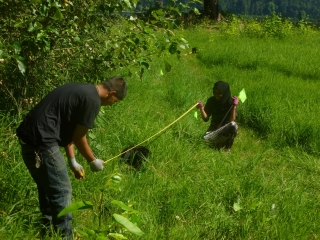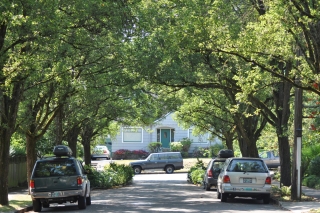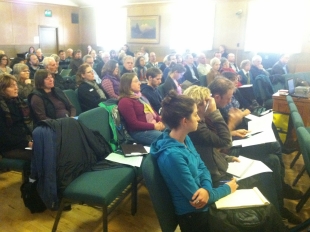 Urban forests—and urban forestry—can play a key role in addressing some of the central challenges facing urban regions, such as climate change, education and youth engagement, the rising costs for health care, and wastewater management. Addressing these issues requires new partnerships and new approaches. This project undertakes to substantially broaden the constituency for and relevancy of urban forestry and elevate it in the eyes of policymakers and the public.
Urban forests—and urban forestry—can play a key role in addressing some of the central challenges facing urban regions, such as climate change, education and youth engagement, the rising costs for health care, and wastewater management. Addressing these issues requires new partnerships and new approaches. This project undertakes to substantially broaden the constituency for and relevancy of urban forestry and elevate it in the eyes of policymakers and the public.
Across the region, urban forests are estimated to contain about 6.9 million trees with an estimated structural asset value of $4.3 billion. Beyond aesthetics, urban forests also provide innumerable other services that affect both the local physical environment and the social environment in the places we live, work, learn and play including:
Air quality –Trees trap and filter harmful emissions and pollutants by exchanging gases with the atmosphere and capturing particulates such as ozone and carbon monoxide in their leaves.
Water quality and flow –It is estimated that 100 mature trees intercept about 250,000 gallons of rainwater per year, reducing stormwater run-off and providing clean water.
Erosion control and soil quality – Tree roots decrease erosion by holding the soil in place and remediate soils by absorbing, transforming, and containing contaminants.
Wildlife habitat and biodiversity – The urban forest provide shelter and food for a variety of birds and animals, increasing the biodiversity of urban natural systems.
 Real estate and property values – Trees in urban residential areas can enhance real estate sales by 3 to 7 percent.
Real estate and property values – Trees in urban residential areas can enhance real estate sales by 3 to 7 percent.
Economic development – Healthy mature trees are a major economic asset for attracting and retaining residents, businesses and visitors.
Regional tourism - Trees contribute to regional tourism, boosting visitation to many of the region’s most popular natural attractions.
Local climate and energy use –Trees influence thermal comfort and energy use by providing shade, transpiring moisture, and reducing wind speed.
Community well-being and involvement –Trees and landscaping create pedestrian-friendly streets, increasing the attractiveness of walking and active living, and have even been shown to lower crime primarily by bringing people together outdoors, increasing surveillance and discouraging criminal activity.
Individual and community health – Urban forests and greenways have significant, positive health influences, providing a wide range of physiological and psychological benefits that contribute to healthy communities.
 In the Spotlight: INTERTWINE PLANT OFF
In the Spotlight: INTERTWINE PLANT OFF
Engaging youth in helping expand and restore the region’s urban forests
As part of our urban forestry work, The Intertwine Alliance created an event called Plant Off to engage youth teams in planning, promoting and leading tree planting events in their neighborhoods. The project was a partnership of Friends of Trees, Clean Water Services, Metro, Moda Health, Tualatin Riverkeepers, Groundwork Portland, Supa Fresh Youth Farm, Frank Creative, KEEN Footwear and the National Park Service.
With the support of these 10 public, private and nonprofit organizations, two teams of racially diverse youth organized, promoted and led tree planting events in their communities on Nov. 1, 2014.
The youth participated in a series of workshops where they learned the importance of trees to watersheds, developed a plan for their planting sites, worked with a marketing and public relations firm to produce and implement an advertising campaign, served as leaders of the planting events, and reported their results at a conference of more than 200 conservation leaders.
The events helped kick off a campaign called Tree for All that planted more than 1 million native trees and shrubs in a year. As part of this project, more than 16,000 trees were planted on almost 12 acres. The youth were able to attract a much more diverse group of participants than similar events in the past and for many participants this was their first conservation-oriented event ever.
Nov. 2014 Urban Forestry Summit attracts eager participation
 More than 80 people gathered in Tualatin on Nov. 18, 2014, for the Urban Forestry Summit, an Intertwine Alliance event led by Tualatin Riverkeepers, the Oregon Department of Forestry and arborists Teragan and Associates.
More than 80 people gathered in Tualatin on Nov. 18, 2014, for the Urban Forestry Summit, an Intertwine Alliance event led by Tualatin Riverkeepers, the Oregon Department of Forestry and arborists Teragan and Associates.
A portion of the discussion was about the new urban forestry code that had been recently adopted by the City of Tigard, which prevents clearing before development and encourages steady growth of tree canopy in the city. To read notes about the full range of challenges discussed, along with the solutions offered, click here.
You can also read "Urban Forest Fire," a piece that Brian Wegener of Tualatin Riverkeepers wrote about his takeaways from the summit, in the Outside Voice blog.
